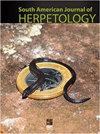哥斯达黎加人与鳄鱼的相互作用分析
IF 0.7
4区 生物学
Q4 ZOOLOGY
引用次数: 6
摘要
摘要由于人类的扩张,鳄鱼(尖吻鳄)和凯门鳄(凯曼鳄)的栖息地受到了压力。栖息地的减少,加上鳄鱼种群的同时增长,增加了鳄鱼与人类之间的互动次数。目前还没有正式和系统化的互动数据库,但有必要了解互动的规模和性质,并制定管理措施。这项工作的目的是系统化和评估哥斯达黎加鳄鱼与人类之间的相互作用。历史信息是从几个来源收集的。1990年至2017年间,共有99份记录来自新闻报道和环境与能源部环境投诉综合处理系统(SITADA)。消防局在2017年记录了123起事件。消防部门的所有记录都与遭遇或目击事件相对应。在SITADA事件记录中,35.4%为非致命事件,27.3%为致命事件,21.2%为遭遇和目击事件,其余16.1%为其他情况。大多数相互作用发生在白天,这一事实可能是由太阳出来时人类在水体或邻近海岸线上的行为所解释的。大多数互动发生在中太平洋,其次是加勒比海,然后是南太平洋。可用的信息很简短,但可以制定管理措施。该国需要建立一个国家互动数据库,并鼓励个人报告他们的互动。进一步的研究应继续分析数据的趋势,以制定建议,防止负面互动的增加。本文章由计算机程序翻译,如有差异,请以英文原文为准。
Analysis of the Interactions Between Humans and Crocodiles in Costa Rica
Abstract. The habitat of crocodiles (Crocodylus acutus) and caimans (Caiman crocodilus) has been subjected to pressure due to human expansion. Habitat reduction, coupled with the simultaneous growth of the crocodile population, increases the number of interactions between crocodiles and humans. There is currently no official and systematized interactions database, but it is necessary to know the magnitude and nature of the interactions and establish management measures. The objective of the work was to systematize and evaluate the interactions between crocodiles and humans in Costa Rica. Historical information was collected from several sources. A total of 99 records, dated between 1990–2017, were found from press reports and the Integrated System for Processing Environmental Complaints of the Ministry of Environment and Energy (SITADA). The Fire Department recorded 123 events in 2017. All Fire Department records corresponded to encounters or sightings. Of the SITADA incident records, 35.4% were non-fatal, 27.3% were fatal, 21.2% were encounters and sightings, and the remaining 16.1% were miscellaneous situations. Most interactions occurred during the day, a fact potentially explained by human behavior of being in bodies of water or on adjacent shoreline while the sun is out. Most interactions occurred in the Central Pacific, followed by the Caribbean and then the South Pacific. The information available is brief but allows to establish management measures. The country needs to create a national database of interactions and to encourage individuals to report their interactions. Further research should continue to analyze the data for trends with the goal of building recommendations to prevent an increase in negative interactions.
求助全文
通过发布文献求助,成功后即可免费获取论文全文。
去求助
来源期刊
CiteScore
1.50
自引率
0.00%
发文量
10
期刊介绍:
The South American Journal of Herpetology (SAJH) is an international journal published by the Brazilian Society of Herpetology that aims to provide an effective medium of communication for the international herpetological community. SAJH publishes peer-reviewed original contributions on all subjects related to the biology of amphibians and reptiles, including descriptive, comparative, inferential, and experimental studies and taxa from anywhere in the world, as well as theoretical studies that explore principles and methods.

 求助内容:
求助内容: 应助结果提醒方式:
应助结果提醒方式:


